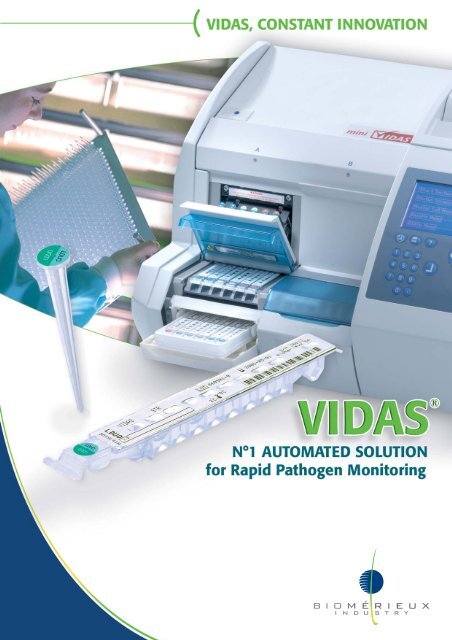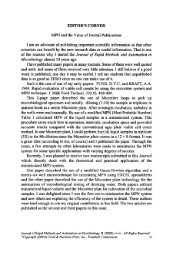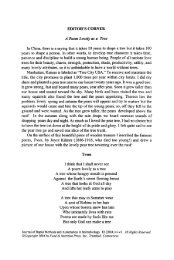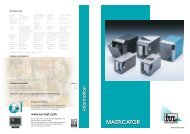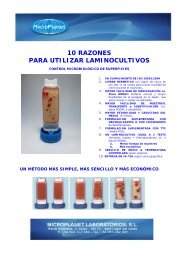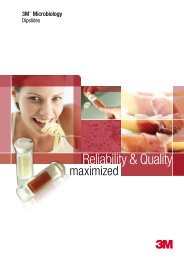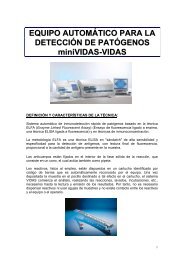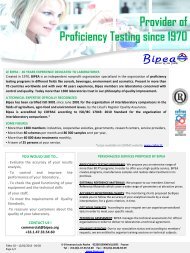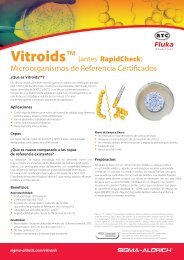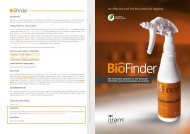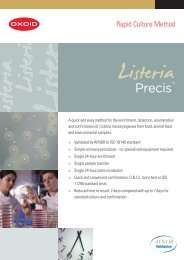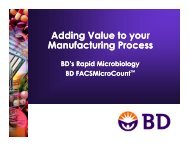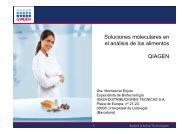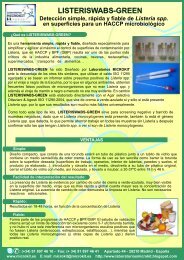8 P. Vidas Indus.-VA
8 P. Vidas Indus.-VA
8 P. Vidas Indus.-VA
Create successful ePaper yourself
Turn your PDF publications into a flip-book with our unique Google optimized e-Paper software.
(<br />
( VIDAS a solution used in numerous reference<br />
N°1 TO ANSWER YOUR NEEDS WOR<br />
VIDAS a worldwide installed base<br />
With more than 2.000 food laboratories who have chosen VIDAS solutions for their routine<br />
analyses, bioMérieux ® is the worldwide leader in automated solutions for pathogen screening.<br />
Present on five continents, VIDAS provides a unique solution<br />
among international partners in the food industry.<br />
laboratories<br />
Approximately 100 worldwide reference<br />
laboratories (FDA, other government<br />
laboratories) and major international food<br />
companies use VIDAS for reliable analyses.<br />
CERTIFIED
LDWIDE<br />
VIDAS a solution used in numerous reference laboratories<br />
The international validations obtained for VIDAS assure food companies<br />
an official recognition for microbiological results on their export markets.<br />
AOAC International Validation<br />
VIDAS Salmonella (SC + TT) (AOAC - OMA May 1996 - Official Method N° 996.08)<br />
VIDAS Salmonella (RV + TT) (AOAC - OMA January 2004 - Official Method N° 2004.03)<br />
VIDAS ICS/plate (AOAC - OMA April 2001 - Official Method N° 2001.07)<br />
VIDAS ICS/SLM<br />
(AOAC - OMA April 2001 - Official Method N° 2001.08)<br />
(AOAC - OMA April 2001 - Official Method N° 2001.09)<br />
VIDAS Listeria (AOAC - OMA May 1999 - Official Method N° 999.06)<br />
VIDAS Listeria (harmonized protocol) (AOAC - OMA June 2004 - Official Method N° 2004.06)<br />
VIDAS Listeria (AOAC RI Performance Tested SM Method December 1998 - Certificate N° 981202)<br />
VIDAS Listeria species Xpress (AOAC RI Performance Tested SM Method October 2005 - Certificate N° 100501)<br />
VIDAS Listeria monocytogenes II (AOAC - OMA January 2004 - Official Method N° 2004.02)<br />
VIDAS SET2 (AOAC - RI Performance Tested SM Method September 2004 - Certificate N° 070404)<br />
VIDAS ECO + O157:H7 ID plate (AOAC - RI Performance Tested SM VIDAS NEXT DAY<br />
VIDAS NEXT DAY<br />
8 hours and 24 hours protocols<br />
Method January 2005 - Certificate N° 010504)<br />
AFNOR Validation<br />
VIDAS Salmonella Dual selective enrichment (April 6 th 1994 - Attestation : Bio-12/01-04/94)<br />
Single selective enrichment (September 18 th 2002 - Attestation : Bio-12/10-09/02)<br />
Easy SLM (September 20 th 2005 - Attestation : Bio-12/16-09/05)<br />
VIDAS Listeria (June 17 th 1994 - Attestation : Bio-12/02-06/94)<br />
VIDAS Listeria species Xpress (July 01 st 2004 - Attestation : Bio-12/12-07/04)<br />
VIDAS Listeria monocytogenes II (July 3rd 2002 - Attestation : Bio-12/09-07/02)<br />
(March12 nd 2004 - Attestation : Bio-12/11-03/04)<br />
VIDAS Listeria DUO (March 9th 2006 - Attestation : Bio-12/18-03/06)<br />
VIDAS ICS plate (March 23th 1999 - Attestation : Bio-12/07-03/99)<br />
VIDAS ICS/SLM (March 23th 1999 - Attestation : Bio-12/06-03/99)<br />
VIDAS E. coli O157 (+ ICE) (July 5th VIDAS NEXT DAY<br />
VIDAS NEXT DAY<br />
2000 - Attestation : Bio-12/08-07/00)<br />
Official Method, DGAL, Ministry of Agriculture<br />
VIDAS SET2 (July 2005 - DGAL/SDSSA/SDRRC/N2005-8194)<br />
NORD<strong>VA</strong>L Validation<br />
VIDAS Salmonella (May 2001 - N° 2005-30-5408-00041)<br />
VIDAS Listeria (May 2001 - N° 2005-30-5408-00042)<br />
VIDAS Listeria monocytogenes II (March 2003 - N° 2005-30-5408-00040)<br />
VIDAS ICS/SLM VIDAS NEXT DAY<br />
(September 2003 - N° 2005-30-5408-00049)<br />
EMMAS assessment<br />
VIDAS Salmonella (October 1998 - Report n° 37490)<br />
VIDAS Listeria (October 1998 - Report n° 37489)<br />
Health Protection Branch of Canada<br />
VIDAS Salmonella (October 1999 - N° MFHPB 24)<br />
VIDAS Listeria (January 2003 - N° MFHPB 29)<br />
VIDAS Listeria monocytogenes II (January 2003 - N° MFLP 33)<br />
DIN Commitee<br />
VIDAS Salmonella (March 2000 - DIN 10121)<br />
Japan Ministry of Health and Welfare<br />
VIDAS E. coli O157<br />
China Government<br />
VIDAS E. coli O157 (September 2000 - SN/T 0973)<br />
VIDAS Listeria monocytogenes II (December 2005 - SN/T 0184.1)<br />
(
(<br />
(<br />
THE BENEFITS OF AUTOMATION IN<br />
VIDAS proven results<br />
More than 150 scientific posters and publications have demonstrated the quality<br />
of VIDAS results :<br />
VIDAS Enzyme-Linked Fluorescent Immunoassay for Detection of Salmonella in Foods : Collaborative Study<br />
M.S. Curiale, V. Gangar, C. Gravens<br />
Journal of AOAC International vol. 80, No.3, 1997<br />
99 % agreement with BAM/AOAC method<br />
Evaluation of the VIDAS Salmonella Reagent for the Detection of Salmonella in Breeding and Veterinary Samples<br />
D. Baroux, M. Neyron, E. Desmaris, M.T. Lescure<br />
presented at SFM Annual Meeting, Paris, October 20, 2000<br />
98 % agreement with reference method<br />
Sensitivity : 96 % (reference method : 94 %)<br />
Specificity : 96 % (reference method : 100 %)<br />
Rapid Salmonella Detection using an Automated Immuno-Enrichment System<br />
F. Bourouina and coll.<br />
presented at Salmonella and Salmonellosis, Ploufragran, 1997<br />
Specificity<br />
: 100 %<br />
Specificity<br />
: 99 %<br />
A comparison of VIDAS Listeria monocytogenes II with the EN ISO 11290-1 Method for the detection<br />
of L. monocytogenes in Food Samples<br />
S. Souchon and coll.<br />
Presented at IAFP Annual meeting, San Diego, 2002<br />
Sensitivity<br />
: 96.7%<br />
Specificity<br />
: 97.9%<br />
Evaluation of VIDAS LDUO Method in Comparison with Standard Method - Validation AFNOR<br />
Sensitivity<br />
: LIS : 94.6 % (reference method : 90.7 %)<br />
LMO : 96.1 % (reference method : 91 %)<br />
Specificity<br />
: 100 % (reference method : 100 %)<br />
Evaluation of VIDAS Campylobacter Method in Comparison with Standard Method<br />
P. Kradolfer, A. Bouchet<br />
presented at ASM Annual Meeting, Atlanta, GA, May 20, 1998<br />
Sensitivity<br />
: 98 % (reference method : 93 %)<br />
Specificity<br />
: 100 % (reference method : 100 %)<br />
VIDAS new developments for your laboratory<br />
Thanks to its R&D laboratory dedicated specifically for VIDAS solutions, bioMérieux proposes<br />
innovations for pathogen screening and enlarges its range of applications for VIDAS solutions :<br />
Specific<br />
evaluation of food matrices<br />
Development<br />
of protocols appropriate for the environment<br />
VIDAS<br />
solutions for emerging pathogens
YOUR LABORATORY<br />
VIDAS an automated system to optimize your weekly workflow<br />
SALMONELLA<br />
LISTERIA<br />
E. COLI O157:H7<br />
MONDAY TUESDAY WEDNESDAY THURSDAY FRIDAY SATURDAY<br />
12 PM 12 PM 12 PM 12 PM 12 PM 12 PM<br />
With improved productivity, the laboratory can initiate testing for the entire week and can better<br />
distribute the weekly workflow.<br />
Rapid testing results provides the means for rapid corrective actions or immediate release of lots<br />
in control.<br />
(<br />
BAM METHOD<br />
VIDAS SLM<br />
VIDAS ICS PLATE<br />
VIDAS ICS - SLM<br />
VIDAS NEXT DAY *<br />
BAM METHOD<br />
ISO METHOD<br />
VIDAS LIS<br />
VIDAS LMO2<br />
PERFORMANCE INSIDE<br />
VIDAS LSX<br />
VIDAS NEXT DAY *<br />
BAM METHOD<br />
VIDAS ECO<br />
*VIDAS J+1
(<br />
(<br />
(<br />
(<br />
mini VIDAS ®<br />
VIDAS ®<br />
A COMPLETE SOLUTION<br />
VIDAS a multi-parametric solution<br />
On the same platform, VIDAS provides detection of toxins or key pathogens in the food industry.<br />
VIDAS a multi-functional solution<br />
The VIDAS system can be utilized for :<br />
Final detection of pathogens : immuno-detection Sample<br />
Preparation : immuno-concentration<br />
VIDAS a large range of applications<br />
With specific protocols, VIDAS allows detection of pathogens at all stages of the food processing<br />
industry :<br />
Human food products<br />
Environmental samples<br />
VIDAS a reliable solution<br />
The<br />
analysis is entirely automated from inserting the sample to reporting results.<br />
An<br />
original design reduces risk due to manipulation or cross-contamination<br />
during the analysis.<br />
Each<br />
analysis has complete traceability (bar code, complete test report).<br />
With<br />
automation, the interpretation is objective whoever the user may be.<br />
With<br />
ready-to-use kits, manipulations are reduced to a minimum.
VIDAS a large range of parameters<br />
SLM<br />
SLM<br />
ICS<br />
ICS<br />
ECO<br />
ECO<br />
ICE<br />
ICE<br />
CAM<br />
CAM<br />
Salmonella<br />
VIDAS Salmonella (SLM)<br />
60 tests - ref 30702<br />
Detection of Salmonella in food products<br />
and environmental samples<br />
Test length : 45 minutes<br />
Results in Day 3<br />
VIDAS Immuno-Concentration Salmonella (ICS)<br />
60 tests - ref 30435<br />
Immuno-concentration of Salmonella in food products<br />
Test length : 40 minutes<br />
Results in Day 2 (ICS + SLM) VIDAS NEXT DAY<br />
Results in Day 3 (ICS + plate)<br />
*<br />
E. coli O157<br />
VIDAS E. coli O157 (ECO)<br />
30 tests - ref 30112<br />
Detection of E. coli O157 in food products<br />
and environmental samples<br />
Test length : 45 minutes<br />
Results in Day 2<br />
VIDAS Immuno-Concentration E. coli O157 (ICE)<br />
30 tests - ref 30526<br />
Facilitates confirmation of E. coli O157<br />
on specific culture media<br />
Test length : 40 minutes<br />
Campylobacter<br />
VIDAS Campylobacter (CAM)<br />
30 tests - ref 30111<br />
Detection of Campylobacter in food products<br />
Test length : 70 minutes<br />
Results in Day 3<br />
(<br />
LIS<br />
LIS<br />
LSX<br />
LSX<br />
LMO2<br />
LMO2<br />
LDUO<br />
LDUO<br />
SET2<br />
SET2<br />
Listeria<br />
VIDAS Listeria (LIS)<br />
60 tests - ref 30700<br />
Detection of Listeria in food products<br />
and environmental samples<br />
Test length : 45 minutes<br />
Results in Day 3<br />
VIDAS Listeria Species Xpress (LSX)<br />
60 tests - ref 30224<br />
Detection of Listeria in meat and dairy products<br />
Test length : 70 minutes<br />
Results in Day 2 VIDAS NEXT DAY *<br />
VIDAS Listeria monocytogenes II (LMO2)<br />
60 tests - ref 30704 PERFORMANCE INSIDE<br />
Detection of Listeria monocytogenes in food products<br />
and environmental samples<br />
Test length : 70 minutes<br />
Results in Day 3<br />
VIDAS Listeria Duo (LDUO)<br />
60 tests - ref 30225<br />
Simultaneous detection of Listeria monocytogenes and<br />
Listeria spp in food products and environmental samples<br />
Test length : 127 minutes<br />
Results in Day 3<br />
Staphylococcal enterotoxins<br />
VIDAS Staph enterotoxin II (SET2)<br />
30 tests - ref 30705<br />
Detection of Staphylococcal enterotoxins<br />
A, B, C1, C2, C3, D and E in food products<br />
Test length : 80 minutes<br />
Results < 24 hours<br />
PERFORMANCE INSIDE<br />
*VIDAS J+1
03-06/ 006GB99015C / This document is not legally binding. bioMérieux reserves the right to modify specifications without notice / BIOMERIEUX and the blue logo, VIDAS are registered<br />
and protected trademarks belonging to bioMérieux SA or one of its subsidiaries / bioMérieux SA RCS Lyon 673 620 399 / Printed in France / TL McCANN Santé Lyon / RCS Lyon B 398 160 242<br />
Example of protocol<br />
Reagent strip<br />
Sample<br />
Diluent<br />
SPR<br />
Washing<br />
buffer<br />
bioMérieux SA<br />
69280 Marcy l’Etoile • France<br />
Tel. 33 (0)4 78 87 20 00<br />
Fax 33 (0)4 78 87 20 90<br />
www.biomerieux.com<br />
(<br />
(<br />
bioMérieux<br />
a complete offer<br />
from enrichment to detection<br />
In order to assure you the best reliability for pathogen detection on VIDAS, bioMérieux<br />
has developed a range of enrichment media where the performance is controlled using VIDAS<br />
as well as a large choice of selective media.<br />
For optimal use, these media are provided in a ready-to-use format.<br />
bioMérieux also offers the API range, the worldwide reference for identification, for a practical<br />
and standardized confirmation of positive results.<br />
Fixed antibody<br />
Substrate<br />
Washing<br />
buffer<br />
Conjugate<br />
The antibody captures the target<br />
pathogen.<br />
A COMPLETE SOLUTION<br />
How does it work ?<br />
Antigen Capture Sandwich Assay Detection<br />
Sandwich Antibody conjugated<br />
to alkaline phosphatase<br />
Antigen<br />
to be tested<br />
Fixed antibody<br />
A second antibody conjugated<br />
with an enzyme fixes itself<br />
to the captured antigen.<br />
4-methyl<br />
umbelliferyl<br />
phosphate<br />
The intensity of the fluorescence<br />
is interpreted by the system.<br />
DESIGNED TO HELP PROTECT<br />
THE REPUTATION OF YOUR BRANDS
EQUIPO AUTOMÁTICO PARA LA<br />
DETECCIÓN DE PATÓGENOS<br />
miniVIDAS-VIDAS<br />
DEFINICIÓN Y CARACTERÍSTICAS DE LA TÉCNICA:<br />
Sistema automático de inmunodetección rápida de patógenos basado en la técnica<br />
ELFA (Enzyme Linked Fluorescent Assay) (Ensayo de fluorescencia ligado a enzima,<br />
una técnica ELISA ligada a fluorescencia) y en técnicas de inmunoconcentración.<br />
La metodología ELFA es una técnica ELISA en "sándwich" de alta sensibilidad y<br />
especificidad para la detección de antígenos, con lectura final de fluorescencia,<br />
proporcional a la cantidad de antígeno presente en la muestra.<br />
Los anticuerpos están fijados en el interior de la fase sólida de la reacción, que<br />
consiste en un cono, el cual actúa también como pipeta.<br />
Los reactivos, listos al empleo, están dispuestos en un cartucho identificado por<br />
código de barras que es automáticamente reconocido por el equipo. Una vez<br />
depositada la muestra en el pocillo destinado a tal efecto en el cartucho, el sistema<br />
VIDAS comienza el análisis, realizando las reacciones, lavados, incubaciones, etc.,<br />
necesarios hasta la lectura y emisión de los resultados. Por tanto, no es necesario<br />
dispensar reactivos ni usar agujas de muestreo y no existe contacto entre los reactivos<br />
y el equipo o el operario.<br />
1
El equipo realiza la técnica ELFA automáticamente, sin necesidad de intervención de<br />
personal, tal y como se describe a continuación:<br />
- Los antígenos presentes en el medio de cultivo se fijan a los anticuerpos<br />
situados en la pared interna del cono.<br />
- Los elementos libres (no fijados) son eliminados a lo largo de diferentes<br />
fases de lavado.<br />
- Los anticuerpos conjugados marcados con fosfatasa alcalina (contenidos<br />
en uno de los pocillos del cartucho) son aspirados dentro del cono y se<br />
fijan sobre los antígenos ya unidos a los anticuerpos de la pared del<br />
cono.<br />
- Nuevas etapas de lavado eliminan el conjugado no fijado.<br />
- Un sustrato (4 metil-umbeliferil-fosfato), es introducido en el cono.<br />
- La enzima que queda en las paredes del cono cataliza entonces la<br />
transformación del sustrato en una molécula fluorescente: la 4-metilumbeliferona.<br />
- La intensidad de la fluorescencia es medida a través del sistema óptico<br />
del sistema VIDAS a 450 nm.<br />
Al terminar la técnica, los resultados son analizados automáticamente por el equipo,<br />
que suministra un valor de test (VT) para cada muestra. Este valor es comparado con<br />
las referencias internas (umbrales) y cada resultado es interpretado como positivo o<br />
negativo.<br />
También se puede utilizar el robot VIDAS como un sistema de<br />
inmunoconcentración que permite eliminar los sucesivos pases de enriquecimiento<br />
selectivo que se emplean en las técnicas tradicionales.<br />
2
PRINCIPALES VENTAJAS:<br />
El equipo presenta las siguientes ventajas frente a la microbiología tradicional y frente<br />
a otras técnicas rápidas:<br />
• Equipo compacto multiparamétrico de inmunoanálisis.<br />
• Parámetros: Salmonella spp., Listeria monocytogenes, Listeria spp, enterotoxina de<br />
S. aureus, E. coli 0157: H7, Campylobacter.<br />
• Sistema completamente automatizado a partir de la inoculación de la muestra en el<br />
equipo hasta la lectura e interpretación de resultados.<br />
• Reactivos listos al empleo en un formato exclusivo, desechable y práctico:<br />
a) Un cartucho que contiene los reactivos ya preparados para procesar<br />
automáticamente la muestra.<br />
b) Un cono recubierto de anticuerpos que realizarán de forma selectiva la<br />
inmunoconcentración y/o detección del patógeno.<br />
• Reducción de las etapas de manipulación en la fase de preparación de la muestra.<br />
El resto del ensayo se realiza automáticamente en el sistema.<br />
• Impresión automática de resultados al concluir cada análisis.<br />
• Posibilidad de exportar resultados y datos a un sistema informático externo de<br />
gestión de datos de laboratorio (LIMS).<br />
Lo que se consigue con el sistema VIDAS es agilizar los controles microbiológicos y a<br />
la vez acortar el periodo de obtención de los resultados, lo que permite la liberación<br />
del producto controlado con plenas garantías al estar sometida la técnica a<br />
validaciones oficiales.<br />
CALIDAD DE LOS MATERIALES:<br />
• En el procesado de las muestras por el sistema miniVIDAS, no existe contacto<br />
entre el reactivo y la máquina, ni válvulas de succión/expulsión de líquidosreactivos,<br />
con lo que se disminuyen los riesgos y desgastes derivados de la<br />
contaminación (circulación de las muestras por el interior del sistema).<br />
• El MTBF (tiempo medio de intervención entre fallo y fallo del sistema) es de 1.115<br />
días sin averías, demostrando la gran robustez de los materiales utilizados.<br />
CAPACIDAD DE ANÁLISIS:<br />
• La sensibilidad del método permite detectar a partir de 2-3 UFC en la muestra<br />
original.<br />
3
• En algunos protocolos las muestras se tratan térmicamente para inactivarlas y a la<br />
vez favorecer la unión antígeno anticuerpo.<br />
• La mayoría de los protocolos han sido validados por AFNOR, AOAC y otros<br />
organismos de reconocimiento internacional.<br />
• Los protocolos de trabajo para cada parámetro son cerrados e idénticos,<br />
independientemente del tipo de muestra (materia prima o producto elaborado).<br />
• Respuesta cualitativa: positivo (presencia) / negativo (ausencia).<br />
CALIBRACIONES :<br />
• No necesita ni calibradores ni controles cada vez que se realiza un ensayo.<br />
• No es necesario introducir un estándar para la calibración, cada vez que se realiza<br />
un test. Las calibraciones se realizan una vez para cada lote y/o cada 15 días y son<br />
archivadas en el software, para la realización de la totalidad de las muestras en los<br />
días sucesivos.<br />
• Por este mismo motivo tampoco es necesario poner controles positivos y negativos<br />
cada vez que se realiza un test.<br />
• Los estándares y controles positivos y negativos vienen incluidos en cada caja de<br />
reactivos, por si fuera necesario proceder a controles de calidad del reactivo.<br />
ACTUALIZACIÓN DEL EQUIPO:<br />
• Al tratarse de un robot el equipo evoluciona con las nuevas técnicas: actualmente<br />
es un equipo abierto que utiliza las técnicas de inmunoconcentración e<br />
inmunodetección, pero se está también desarrollando su aplicación para<br />
automatizar la detección de patógenos basada en la tecnología de la proteina<br />
recombinante de fagos.<br />
Los últimos desarrollos y mejoras han sido:<br />
• VIDAS LMX: detección de Listeria monocytogenes en 27 horas.<br />
• VIDAS LDUO: detección de Listeria spp. y Listeria monocytogenes<br />
simultáneamente en el mismo análisis en 48 horas.<br />
• VIDAS easySALMONELLA: disminución de la manipulación en el protocolo de<br />
Salmonella.<br />
• VIDAS HEAT & GO: para minimizar aún mas la manipulación (ahorro de pasos<br />
de pipeteo) en los protocolos que requieren paso de calentamiento de la<br />
muestra.<br />
• VIDAS E. coli O157H7: detección del serotipo enterohemorrágico E. coli<br />
O157:H7 en 7-16 horas empleando la tecnología de fagos.<br />
• En desarrollo: VIDAS SPT (detección de Salmonella spp. empleando la<br />
tecnología de fagos<br />
4
BENEFICIOS Y REPERCUSIÓN:<br />
Los beneficios y repercusión de la implantación del sistema VIDAS en un laboratorio<br />
de análisis de alimentos son:<br />
- La prevención de irregularidades, la anticipación de situaciones adversas por<br />
el control de materias primas y procesos productivos y la obtención de la información<br />
necesaria que permite que se llegue a un estándar de calidad óptimo del producto,<br />
garantizando la ausencia de fallos en el punto de venta.<br />
- El rápido análisis de los parámetros de medida incide de forma importante en<br />
la detección precoz de anomalías y facilita y acelera la toma de decisiones en temas<br />
tan importantes como:<br />
Gestión de los ciclos de producción.<br />
Gestión de stock y reducción del inmovilizado con una disminución del<br />
tiempo de análisis de menos de 24h en el caso de Salmonella y Listeria<br />
monocytogenes.<br />
- Seguridad en la detección de microorganismos, ya que el sistema realiza un<br />
procedimiento ELISA automático de la muestra, que elimina los posibles errores de<br />
manipulación humana y emplea técnicas altamente selectivas de detección por<br />
inmunoensayo combinado con fluorescencia. De ahí que los parámetros utilizados se<br />
hayan sometido a validación por entidades mundialmente reconocidas (AOAC,<br />
AFNOR) que han establecido la sensibilidad, especificidad y reproducibilidad del test.<br />
- Sencillez en el manejo del equipo combinado con rapidez en la obtención de<br />
resultados y facilidad en la interpretación de los mismos debido a que el sistema<br />
realiza un tratamiento automático e informatizado de datos, mejorando globalmente la<br />
gestión e imagen en el departamento de control de calidad.<br />
- Repetitibilidad y reproducibilidad de los ensayos superior a los métodos<br />
tradicionales de recuento en placa.<br />
- Fiabilidad en el espectro de detección, en la sensibilidad y en los tiempos de<br />
preincubación y análisis, reduciendo así los riesgos de obtención de resultados falsos<br />
negativos. La fiabilidad de resultados se garantiza por la utilización de material<br />
desechable sometido a normas de garantía de calidad y por los medios y reactivos<br />
listos al empleo.<br />
- Productividad elevada en el tratamiento de muestras, ya que el aparato está<br />
adaptado a grandes series (80 test por día).<br />
- Ocupación de un reducido espacio en el laboratorio debido a las pequeñas<br />
dimensiones del equipo.<br />
- Respuesta cualitativa: Positivo o negativo (presencia o ausencia).<br />
- El equipo compacto miniVIDAS dispone de dos secciones de 6 posiciones<br />
cada una que permite procesar 12 muestras de forma simultánea de uno o varios<br />
parámetros distintos al mismo tiempo. El tiempo de realización de los ensayos es de<br />
45-70 minutos desde la introducción de la muestra en el equipo hasta la impresión<br />
automática de resultados, lo que permite procesar un total de 50-80 muestras en una<br />
jornada laboral.<br />
5
(<br />
( VIDAS a solution used in numerous reference<br />
N°1 TO ANSWER YOUR NEEDS WOR<br />
VIDAS a worldwide installed base<br />
With more than 2.000 food laboratories who have chosen VIDAS solutions for their routine<br />
analyses, bioMérieux ® is the worldwide leader in automated solutions for pathogen screening.<br />
Present on five continents, VIDAS provides a unique solution<br />
among international partners in the food industry.<br />
laboratories<br />
Approximately 100 worldwide reference<br />
laboratories (FDA, other government<br />
laboratories) and major international food<br />
companies use VIDAS for reliable analyses.<br />
CERTIFIED
LDWIDE<br />
VIDAS a solution used in numerous reference laboratories<br />
The international validations obtained for VIDAS assure food companies<br />
an official recognition for microbiological results on their export markets.<br />
AOAC International Validation<br />
VIDAS Salmonella (SC + TT) (AOAC - OMA May 1996 - Official Method N° 996.08)<br />
VIDAS Salmonella (RV + TT) (AOAC - OMA January 2004 - Official Method N° 2004.03)<br />
VIDAS ICS/plate (AOAC - OMA April 2001 - Official Method N° 2001.07)<br />
VIDAS ICS/SLM<br />
(AOAC - OMA April 2001 - Official Method N° 2001.08)<br />
(AOAC - OMA April 2001 - Official Method N° 2001.09)<br />
VIDAS Listeria (AOAC - OMA May 1999 - Official Method N° 999.06)<br />
VIDAS Listeria (harmonized protocol) (AOAC - OMA June 2004 - Official Method N° 2004.06)<br />
VIDAS Listeria (AOAC RI Performance Tested SM Method December 1998 - Certificate N° 981202)<br />
VIDAS Listeria species Xpress (AOAC RI Performance Tested SM Method October 2005 - Certificate N° 100501)<br />
VIDAS Listeria monocytogenes II (AOAC - OMA January 2004 - Official Method N° 2004.02)<br />
VIDAS SET2 (AOAC - RI Performance Tested SM Method September 2004 - Certificate N° 070404)<br />
VIDAS ECO + O157:H7 ID plate (AOAC - RI Performance Tested SM VIDAS NEXT DAY<br />
VIDAS NEXT DAY<br />
8 hours and 24 hours protocols<br />
Method January 2005 - Certificate N° 010504)<br />
AFNOR Validation<br />
VIDAS Salmonella Dual selective enrichment (April 6 th 1994 - Attestation : Bio-12/01-04/94)<br />
Single selective enrichment (September 18 th 2002 - Attestation : Bio-12/10-09/02)<br />
Easy SLM (September 20 th 2005 - Attestation : Bio-12/16-09/05)<br />
VIDAS Listeria (June 17 th 1994 - Attestation : Bio-12/02-06/94)<br />
VIDAS Listeria species Xpress (July 01 st 2004 - Attestation : Bio-12/12-07/04)<br />
VIDAS Listeria monocytogenes II (July 3rd 2002 - Attestation : Bio-12/09-07/02)<br />
(March12 nd 2004 - Attestation : Bio-12/11-03/04)<br />
VIDAS Listeria DUO (March 9th 2006 - Attestation : Bio-12/18-03/06)<br />
VIDAS ICS plate (March 23th 1999 - Attestation : Bio-12/07-03/99)<br />
VIDAS ICS/SLM (March 23th 1999 - Attestation : Bio-12/06-03/99)<br />
VIDAS E. coli O157 (+ ICE) (July 5th VIDAS NEXT DAY<br />
VIDAS NEXT DAY<br />
2000 - Attestation : Bio-12/08-07/00)<br />
Official Method, DGAL, Ministry of Agriculture<br />
VIDAS SET2 (July 2005 - DGAL/SDSSA/SDRRC/N2005-8194)<br />
NORD<strong>VA</strong>L Validation<br />
VIDAS Salmonella (May 2001 - N° 2005-30-5408-00041)<br />
VIDAS Listeria (May 2001 - N° 2005-30-5408-00042)<br />
VIDAS Listeria monocytogenes II (March 2003 - N° 2005-30-5408-00040)<br />
VIDAS ICS/SLM VIDAS NEXT DAY<br />
(September 2003 - N° 2005-30-5408-00049)<br />
EMMAS assessment<br />
VIDAS Salmonella (October 1998 - Report n° 37490)<br />
VIDAS Listeria (October 1998 - Report n° 37489)<br />
Health Protection Branch of Canada<br />
VIDAS Salmonella (October 1999 - N° MFHPB 24)<br />
VIDAS Listeria (January 2003 - N° MFHPB 29)<br />
VIDAS Listeria monocytogenes II (January 2003 - N° MFLP 33)<br />
DIN Commitee<br />
VIDAS Salmonella (March 2000 - DIN 10121)<br />
Japan Ministry of Health and Welfare<br />
VIDAS E. coli O157<br />
China Government<br />
VIDAS E. coli O157 (September 2000 - SN/T 0973)<br />
VIDAS Listeria monocytogenes II (December 2005 - SN/T 0184.1)<br />
(
(<br />
(<br />
THE BENEFITS OF AUTOMATION IN<br />
VIDAS proven results<br />
More than 150 scientific posters and publications have demonstrated the quality<br />
of VIDAS results :<br />
VIDAS Enzyme-Linked Fluorescent Immunoassay for Detection of Salmonella in Foods : Collaborative Study<br />
M.S. Curiale, V. Gangar, C. Gravens<br />
Journal of AOAC International vol. 80, No.3, 1997<br />
99 % agreement with BAM/AOAC method<br />
Evaluation of the VIDAS Salmonella Reagent for the Detection of Salmonella in Breeding and Veterinary Samples<br />
D. Baroux, M. Neyron, E. Desmaris, M.T. Lescure<br />
presented at SFM Annual Meeting, Paris, October 20, 2000<br />
98 % agreement with reference method<br />
Sensitivity : 96 % (reference method : 94 %)<br />
Specificity : 96 % (reference method : 100 %)<br />
Rapid Salmonella Detection using an Automated Immuno-Enrichment System<br />
F. Bourouina and coll.<br />
presented at Salmonella and Salmonellosis, Ploufragran, 1997<br />
Specificity<br />
: 100 %<br />
Specificity<br />
: 99 %<br />
A comparison of VIDAS Listeria monocytogenes II with the EN ISO 11290-1 Method for the detection<br />
of L. monocytogenes in Food Samples<br />
S. Souchon and coll.<br />
Presented at IAFP Annual meeting, San Diego, 2002<br />
Sensitivity<br />
: 96.7%<br />
Specificity<br />
: 97.9%<br />
Evaluation of VIDAS LDUO Method in Comparison with Standard Method - Validation AFNOR<br />
Sensitivity<br />
: LIS : 94.6 % (reference method : 90.7 %)<br />
LMO : 96.1 % (reference method : 91 %)<br />
Specificity<br />
: 100 % (reference method : 100 %)<br />
Evaluation of VIDAS Campylobacter Method in Comparison with Standard Method<br />
P. Kradolfer, A. Bouchet<br />
presented at ASM Annual Meeting, Atlanta, GA, May 20, 1998<br />
Sensitivity<br />
: 98 % (reference method : 93 %)<br />
Specificity<br />
: 100 % (reference method : 100 %)<br />
VIDAS new developments for your laboratory<br />
Thanks to its R&D laboratory dedicated specifically for VIDAS solutions, bioMérieux proposes<br />
innovations for pathogen screening and enlarges its range of applications for VIDAS solutions :<br />
Specific<br />
evaluation of food matrices<br />
Development<br />
of protocols appropriate for the environment<br />
VIDAS<br />
solutions for emerging pathogens
YOUR LABORATORY<br />
VIDAS an automated system to optimize your weekly workflow<br />
SALMONELLA<br />
LISTERIA<br />
E. COLI O157:H7<br />
MONDAY TUESDAY WEDNESDAY THURSDAY FRIDAY SATURDAY<br />
12 PM 12 PM 12 PM 12 PM 12 PM 12 PM<br />
With improved productivity, the laboratory can initiate testing for the entire week and can better<br />
distribute the weekly workflow.<br />
Rapid testing results provides the means for rapid corrective actions or immediate release of lots<br />
in control.<br />
(<br />
BAM METHOD<br />
VIDAS SLM<br />
VIDAS ICS PLATE<br />
VIDAS ICS - SLM<br />
VIDAS NEXT DAY *<br />
BAM METHOD<br />
ISO METHOD<br />
VIDAS LIS<br />
VIDAS LMO2<br />
PERFORMANCE INSIDE<br />
VIDAS LSX<br />
VIDAS NEXT DAY *<br />
BAM METHOD<br />
VIDAS ECO<br />
*VIDAS J+1
(<br />
(<br />
(<br />
(<br />
mini VIDAS ®<br />
VIDAS ®<br />
A COMPLETE SOLUTION<br />
VIDAS a multi-parametric solution<br />
On the same platform, VIDAS provides detection of toxins or key pathogens in the food industry.<br />
VIDAS a multi-functional solution<br />
The VIDAS system can be utilized for :<br />
Final detection of pathogens : immuno-detection Sample<br />
Preparation : immuno-concentration<br />
VIDAS a large range of applications<br />
With specific protocols, VIDAS allows detection of pathogens at all stages of the food processing<br />
industry :<br />
Human food products<br />
Environmental samples<br />
VIDAS a reliable solution<br />
The<br />
analysis is entirely automated from inserting the sample to reporting results.<br />
An<br />
original design reduces risk due to manipulation or cross-contamination<br />
during the analysis.<br />
Each<br />
analysis has complete traceability (bar code, complete test report).<br />
With<br />
automation, the interpretation is objective whoever the user may be.<br />
With<br />
ready-to-use kits, manipulations are reduced to a minimum.
VIDAS a large range of parameters<br />
SLM<br />
SLM<br />
ICS<br />
ICS<br />
ECO<br />
ECO<br />
ICE<br />
ICE<br />
CAM<br />
CAM<br />
Salmonella<br />
VIDAS Salmonella (SLM)<br />
60 tests - ref 30702<br />
Detection of Salmonella in food products<br />
and environmental samples<br />
Test length : 45 minutes<br />
Results in Day 3<br />
VIDAS Immuno-Concentration Salmonella (ICS)<br />
60 tests - ref 30435<br />
Immuno-concentration of Salmonella in food products<br />
Test length : 40 minutes<br />
Results in Day 2 (ICS + SLM) VIDAS NEXT DAY<br />
Results in Day 3 (ICS + plate)<br />
*<br />
E. coli O157<br />
VIDAS E. coli O157 (ECO)<br />
30 tests - ref 30112<br />
Detection of E. coli O157 in food products<br />
and environmental samples<br />
Test length : 45 minutes<br />
Results in Day 2<br />
VIDAS Immuno-Concentration E. coli O157 (ICE)<br />
30 tests - ref 30526<br />
Facilitates confirmation of E. coli O157<br />
on specific culture media<br />
Test length : 40 minutes<br />
Campylobacter<br />
VIDAS Campylobacter (CAM)<br />
30 tests - ref 30111<br />
Detection of Campylobacter in food products<br />
Test length : 70 minutes<br />
Results in Day 3<br />
(<br />
LIS<br />
LIS<br />
LSX<br />
LSX<br />
LMO2<br />
LMO2<br />
LDUO<br />
LDUO<br />
SET2<br />
SET2<br />
Listeria<br />
VIDAS Listeria (LIS)<br />
60 tests - ref 30700<br />
Detection of Listeria in food products<br />
and environmental samples<br />
Test length : 45 minutes<br />
Results in Day 3<br />
VIDAS Listeria Species Xpress (LSX)<br />
60 tests - ref 30224<br />
Detection of Listeria in meat and dairy products<br />
Test length : 70 minutes<br />
Results in Day 2 VIDAS NEXT DAY *<br />
VIDAS Listeria monocytogenes II (LMO2)<br />
60 tests - ref 30704 PERFORMANCE INSIDE<br />
Detection of Listeria monocytogenes in food products<br />
and environmental samples<br />
Test length : 70 minutes<br />
Results in Day 3<br />
VIDAS Listeria Duo (LDUO)<br />
60 tests - ref 30225<br />
Simultaneous detection of Listeria monocytogenes and<br />
Listeria spp in food products and environmental samples<br />
Test length : 127 minutes<br />
Results in Day 3<br />
Staphylococcal enterotoxins<br />
VIDAS Staph enterotoxin II (SET2)<br />
30 tests - ref 30705<br />
Detection of Staphylococcal enterotoxins<br />
A, B, C1, C2, C3, D and E in food products<br />
Test length : 80 minutes<br />
Results < 24 hours<br />
PERFORMANCE INSIDE<br />
*VIDAS J+1
03-06/ 006GB99015C / This document is not legally binding. bioMérieux reserves the right to modify specifications without notice / BIOMERIEUX and the blue logo, VIDAS are registered<br />
and protected trademarks belonging to bioMérieux SA or one of its subsidiaries / bioMérieux SA RCS Lyon 673 620 399 / Printed in France / TL McCANN Santé Lyon / RCS Lyon B 398 160 242<br />
Example of protocol<br />
Reagent strip<br />
Sample<br />
Diluent<br />
SPR<br />
Washing<br />
buffer<br />
bioMérieux SA<br />
69280 Marcy l’Etoile • France<br />
Tel. 33 (0)4 78 87 20 00<br />
Fax 33 (0)4 78 87 20 90<br />
www.biomerieux.com<br />
(<br />
(<br />
bioMérieux<br />
a complete offer<br />
from enrichment to detection<br />
In order to assure you the best reliability for pathogen detection on VIDAS, bioMérieux<br />
has developed a range of enrichment media where the performance is controlled using VIDAS<br />
as well as a large choice of selective media.<br />
For optimal use, these media are provided in a ready-to-use format.<br />
bioMérieux also offers the API range, the worldwide reference for identification, for a practical<br />
and standardized confirmation of positive results.<br />
Fixed antibody<br />
Substrate<br />
Washing<br />
buffer<br />
Conjugate<br />
The antibody captures the target<br />
pathogen.<br />
A COMPLETE SOLUTION<br />
How does it work ?<br />
Antigen Capture Sandwich Assay Detection<br />
Sandwich Antibody conjugated<br />
to alkaline phosphatase<br />
Antigen<br />
to be tested<br />
Fixed antibody<br />
A second antibody conjugated<br />
with an enzyme fixes itself<br />
to the captured antigen.<br />
4-methyl<br />
umbelliferyl<br />
phosphate<br />
The intensity of the fluorescence<br />
is interpreted by the system.<br />
DESIGNED TO HELP PROTECT<br />
THE REPUTATION OF YOUR BRANDS


